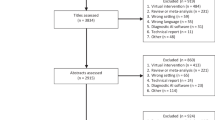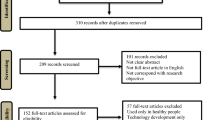Abstract
In care and nursing education systems, students lack opportunities for acquiring the necessary skills and experiences from practice with actual patients. In this paper, we present a patient robot with musculoskeletal symptoms that supports efficient care education for caregivers to investigate the effects of repetitive range of motion (ROM) exercises. Four students and four experts (who have had many years of experience in the medical field) participated in the data acquisition process by performing repetitive ROM tasks using a patient robot. Based on the collected data, the results were analyzed and the effectiveness and feasibility of repetitive ROM exercises conducted using the patient robot were discussed. This study may provide a new pathway for developing advanced patient robots for use in care training environments by imitating the symptoms of various muscle and joint diseases such as palsy, contractures, and muscle weakness.








Similar content being viewed by others
References
Kitajima Y, Nakamura M, Maeda J, Kanai-Pak M, Aida K, Huang Z, Nagata A, Ogata T, Kuwahara N, Ota J (2014) Robotics as a tool in fundamental nursing education. In: International conference on digital human modeling and applications in health, safety, ergonomics and risk management, Springer, pp. 392–402
Huang Z, Katayama T, Kanai-Pak M, Maeda J, Kitajima Y, Nakamura M, Aida K, Kuwahara N, Ogata T, Ota J (2015) Design and evaluation of robot patient for nursing skill training in patient transfer. Adv Robot 29(19):1269–1285
Abrahamson S, Denson JS, Wolf RM (1969) Effectiveness of a simulator in training anesthesiology residents. Acad Med 44(6):515–519
Denson JS, Abrahamson S (1969) A computer-controlled patient simulator. JAMA 208(3):504–508
Darcy AE, Mahoney LE, Hancock AI-C, Curley MAQ (2013) Using high-fidelity simulation to bridge clinical and classroom learning in undergraduate pediatric nursing. Nurse Educ Today 33(6):648–654
Diener E, Hobbs N (2012) Simulating care: Technology-mediated learning in twenty-first century nursing education. Nurs Forum 47:34–38
Huang Z, Lin C, Kanai-Pak M, Maeda J, Kitajima Y, Nakamura M, Kuwahara N, Ogata T, Ota J (2017) Robot patient design to simulate various patients for transfer training. IEEE/ASME Trans Mechatron 22(5):2079–2090
Huang Z, Lin C, Kanai-Pak M, Maeda J, Kitajima Y, Nakamura M, Kuwahara N, Ogata T, Ota J (2016) Impact of using a robot patient for nursing skill training in patient transfer. IEEE Trans Learn Technol 10(3):355–366
Lin C, Ogata T, Zhong Z, Kanai-Pak M, Maeda J, Kitajima Y, Nakamura M, Kuwahara N, Ota J (2021) Development of robot patient lower limbs to reproduce the sit-to-stand movement with correct and incorrect applications of transfer skills by nurses. Appl Sci 11(6):2872
Mouri T, Kawasaki H, Nishimoto Y, Aoki T, Ishigure Y (2007) Development of robot hand for therapist education/training on rehabilitation. In: 2007 IEEE/RSJ International conference on intelligent robots and systems, IEEE, pp. 2295–2300
Fujisawa T, Takagi M, Takahashi Y ,Inoue K, Terada, Kawakami Y, Komeda T (2007) Basic research on the upper limb patient simulator. In: 2007 IEEE 10th International conference on rehabilitation robotics. IEEE, pp. 48–51
United Nations (2013) World population prospects the 2012 revision. https://esa.un.org/unpd/wpp/publications/Files/WPP2012_HIGHLIGHTS.pdf
Oliveira MMF, Gurgel MSC, Miranda MS, Okubo MA, Feijó LFA, Souza GA (2009) Efficacy of shoulder exercises on locoregional complications in women undergoing radiotherapy for breast cancer: clinical trial. Brazil J Phys Therapy 13(2):136–143
Yang EJ, Kim HJ, Ahn HS, Lee EH (2006) The effect of early upper extremities passive exercise on the hand edema and upper spasticity of the hemiplegia patient after stroke. J Korean Clin Nurs Res 12(1):147–157
Kim HJ, Lee Y, Sohng K-Y (2014) Effects of bilateral passive range of motion exercise on the function of upper extremities and activities of daily living in patients with acute stroke. J Phys Therapy Sci 26(1):149–156
Ono T, Miyoshi M, Oki S, Shimizu ME, Umei N, Shiraiwa K, Takemoto H, Shimatani K, Hasegawa M, Otsuka A (2009) The effect of rom exercise on rats with denervation and joint contracture. J Phys Therapy Sci 21(2):173–176
Werner BC, Kuenze CM, Griffin JW, Lyons ML, Hart JM, Brockmeier SF (2013) Shoulder range of motion: validation of an innovative measurement method using a smartphone. Orthop J Sport Med 1(4Suppl):2325967113S00106
Lee M, Ameyama K, Yamazoe H, Lee J-H (2020) Necessity and feasibility of care training assistant robot (cataro) as shoulder complex joint with multi-dof in elderly care education. ROBOMECH J 7(1):1–12
Lee M, Murata K, Ameyama K, Yamazoe H, Lee J-H (2019) Development and quantitative assessment of an elbow joint robot for elderly care training. Intel Serv Robot 12(4):277–287
Zadeh LA (1973) Outline of a new approach to the analysis of complex systems and decision processes. IEEE Trans Syst, Man, and Cybernetics,. https://doi.org/10.1109/TSMC.1973.5408575
Kumar M, Weippert M, Vilbrandt R, Kreuzfeld S, Stoll R (2007) Fuzzy evaluation of heart rate signals for mental stress assessment. IEEE Trans Fuzzy Syst 15(5):791–808
Lee M, Yamazoe H, Lee JH. (2020) Fuzzy-logic based care training quantitative assessment using care training assistant robot (cataro). In: 2020 17th International conference on ubiquitous robots (UR). IEEE, pp. 602–607
Gayathri BM, Sumathi CP (2015) Mamdani fuzzy inference system for breast cancer risk detection. In: 2015 IEEE International conference on computational intelligence and computing research (ICCIC), pp. 1–6
Ahmad G, Khan MA, Abbas S, Athar A, Khan BS, Aslam MS (2019) Automated diagnosis of hepatitis b using multilayer mamdani fuzzy inference system. J Healthc Eng. https://doi.org/10.1155/2019/6361318
BS Medicine (2021) Shoulder range of motion exercises. https://www.bostonsportsmedicine.com/rehabilitation-protocols/shoulder-stretching-exercises/
Acknowledgements
This research was supported by Daegu University Research Grant, 2022.
Author information
Authors and Affiliations
Corresponding author
Ethics declarations
Conflict of interest
The authors declare that they have no conflict of interest.
Informed consent
All subjects agreed to participate in this experiment and signed a consent form, and the researchers worked to ensure their safety.
Additional information
Publisher's Note
Springer Nature remains neutral with regard to jurisdictional claims in published maps and institutional affiliations.
Rights and permissions
Springer Nature or its licensor (e.g. a society or other partner) holds exclusive rights to this article under a publishing agreement with the author(s) or other rightsholder(s); author self-archiving of the accepted manuscript version of this article is solely governed by the terms of such publishing agreement and applicable law.
About this article
Cite this article
Lee, M. Effects of repetitive ROM exercise training using a patient robot with musculoskeletal symptoms. Intel Serv Robotics (2024). https://doi.org/10.1007/s11370-024-00518-5
Received:
Accepted:
Published:
DOI: https://doi.org/10.1007/s11370-024-00518-5




